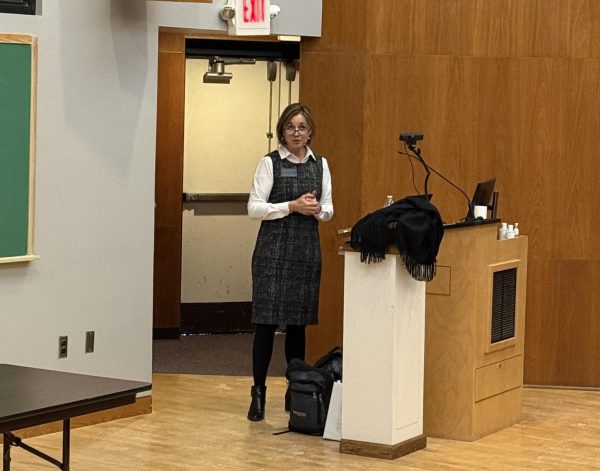Allegheny creates new staffing plan
Provost and Dean of the College Ron Cole shared his faculty staffing plan with members of Allegheny Student Government on Tuesday, Feb. 20.
As the number of students attending Allegheny decreases, the number of faculty needs to follow suit, which has raised concerns by students, according to Cole.
“You have every right to see and be privy to the same information as the faculty and the rest of the campus,” Cole said. “I’d rather have real information, whether we like it or not, than false accusations and assumptions.”
Cole presented the same PowerPoint slide to students that had been shown to faculty earlier in the year. The first slide presented a graph with the number of high school graduates nationally. In the early to mid 2000s, as the number of high school graduates increased, so did the number of students attending Allegheny. Cole called this the college’s growth phase. The college went from 140 faculty to almost 190 faculty.
“About four years ago we reached a peak and started to decline nationally with the number of high school graduates,” Cole said. “About the same time [as the decline], Allegheny experienced a disruption in our planning where we didn’t quite meet what we were projecting for in the number of new students.”
In the next six to seven years, Cole believes the college will hit a peak and then face a sharp decline in students who will be interested in a liberal arts college like Allegheny. The school decided it needs to be proactive and think about strategies to prepare for the decrease in the raw number of students and how it will affect the college, according to Cole.
In the early 2000s, the school grew from around 1,850 students to about 2,100 students, according to Cole’s graph. This number was maintained until the country experienced a national decrease in high school graduates, leading to fewer enrolled students at Allegheny.
The faculty staffing plan Cole prepared is meant to maintain the breadth of the Allegheny curriculum as well as possible, since it is the school’s core mission, according to Cole.
“This is the foundation for major–minor combinations. It provides a distinct approach to how we do interdisciplinary learning, interdisciplinary majors, interdisciplinary programs,” Cole said. “Believe it or not, that’s fairly distinct at Allegheny college compared to other schools like us.”
Cole hopes to keep a 12-to-1 student to faculty ratio with about 1,700 students and around 142 professors, which equates to small class sizes and independent studies. According to Cole, if the ratio gets bigger, there will be fewer opportunities for students.
One way the school plans to combat the ratio gap between students and faculty is through a retirement incentive. This incentive is a buyout of employees at retirement age who want to accept it and retire.
“Nobody was forced to take this. This was completely voluntary,” Cole said. “There was not a single conversation that I had where faculty would come and see me to talk to me about this and I would talk someone in or out of this. It was a personal decision.”
Forty-five employees accepted the incentive, including 23 faculty and 22 staff and administration, according to Cole. The retirements of faculty were spread across the curriculum and were not from any one area.
There were faculty at retirement age in almost every department with more professors notifying Cole that they plan to retire in the next three years.
With the loss of faculty, Zach Javorksy, ’18, wanted to know if this would affect students when it came to majors.
“To clarify, there are currently no plans for any academic departments to not be accepting incoming students for next fall,” Javorksy asked.
Cole explained that the art history and German majors will no longer be available moving forward, but there will still be a German minor. The school also plans on implementing a studio art technology program and for students who are interested in these majors now, there are strategies in place for them.
“Students are already told to be cautious of professors being overbooked with how many students they have and over advising while looking to declare their major,” David Roach, ’21, said.
In response, Cole explained that there will always be certain faculty members who have more advisees than others, and some faculty members will have to say no. This will give faculty advisers with a small number of advisees the ability to take on more students.
As faculty members leave Allegheny, Alexia Porche, ’19, mentioned the college’s retention rate and the number of students who are leaving the college.
In order to combat retention rates, the college has recently partnered with the John N. Gardner Institute, a nonprofit that partners with institutions of higher education, according to Cole. This institute “helps to create and subsequently implement evidence-based plans for improving student learning, success, retention and completion through a variety of processes, expert guidance and support,” according to its website.
The biggest factors of retention rates are the academic and financial aid gaps, according to Cole. The college is currently working on financial aid models and is trying to provide greater resources to students. However, the college cannot change the preparation students receive from high school educations.
“I’m sorry, but I’m not a big fan of No Child Left Behind and the testing mentality,” Cole said. “It totally erodes and undermines the critical analysis and creative thinking that we need to develop at places like Allegheny.”

Students with a GPA below 2.1 during their first semester at Allegheny have a drastic drop in retention rates. This does not mean they are less intelligent, they just have not had the same preparation, according to Cole. With a decline in high school graduates and students attending Allegheny, Cole wants to do everything he can to help students succeed at Allegheny and keep the college on the correct course.
“Yes, we’re going to have fewer faculty moving forward, and yes, we’re going to have fewer students as the national trend [continues to decrease],” Cole said. “We would rather recruit fewer students and become a smaller, more selective college and provide resources for the students here.”





